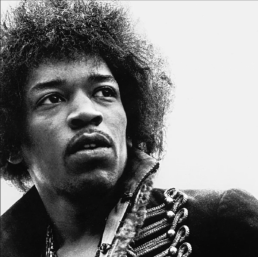These life stories may contain descriptions of childhood trauma and abuse, as well as images, voices and names of people now deceased. If you need help, you can find contact details for some relevant support services on our support page.
Legendary African American guitarist, Jimi Hendrix (1942-1970), was in foster care as a child.
Jimi Hendrix was born James Marshall Hendrix in Seattle, Washington to seventeen-year-old Lucille and James ‘Al’ Hendrix. Al was in the military and stationed in Alabama at the time of Jimi’s birth and was not allowed to take leave to go home. He was subsequently sent overseas and did not see his son until he was discharged in 1945.
Lucille struggled with caring for her baby so her mother, Clarice Jeter, moved in to help. Both women worked low paid jobs which often meant baby Jimi was not well cared for. Eventually, Jimi was given to a Mrs Champ—one of Clarice’s friends—and was moved to Berkeley, California. Al retrieved his son from Mrs Champ in 1945 and returned to live with Lucille in Seattle. After the couple divorced in 1951, Al was given custody of Jimi and his younger brother, Leon.
When Lucille died in 1958, Al bought Jimi a ukulele and music became a way for the boy to express his feelings. As music began to dominate in Jimi’s life, he lost interest in school. He left high school early and worked as a landscape gardener for a while, but he did not enjoy the work.
This left Jimi with little means for making money and soon he ran afoul of the law. At age nineteen, in the summer of 1961, Jimi was arrested for an incident involving a stolen car. He spent a week in jail and received a two year suspended sentence because he agreed to join the military. (Moskowitz, 4).
Jimi Hendrix was in the military for less than twelve months before he was discharged.
From 1962 he was on the road for seven years with a “motley succession of club bands”, making his recording debut with Lonnie Youngblood (b. 1941) at the end of 1963.
In 1966, Hendrix joined with bassist Noel Redding (1945-2003) and drummer John Mitchell (1946-2008) to form the Jimi Hendrix Experience.
In concert, Hendrix often chose to go with the flow, taking his melodies and riff ideas out on distended solo detours, leaving Mitchell to strike his own parallel rhythm path while Redding usually maintained a steady course. But on record, especially in the tightly focused three- and four-minute performances on Are You Experienced?, you can hear the form and force of the Experience in pummeling microcosm (Frinke).
Hendrix quickly shot to fame in London and then in America at the Monterey Pop Festival in June 1967. The group had a punishing schedule of concert tours, interviews, and recording. In mid-1969, the group broke up, exhausted. Hendrix then struck out on his own, until he was rushed to hospital on 18 September 1970, “where he was pronounced dead on arrival.”
Henrix’ career was short but significant.
…he recorded five albums which forever changed the course of American music and influenced countless other musicians who followed (Jet).
References:
Fricke, David. “Jimi: The man and the music”. Rolling Stone, 6 February 1992, p. 40.
“Jimi Hendrix: November 27, 1942”. Jet, vol. 89, no. 3, (1955); p. 20.
Moskowitz, David. The Words and Music of Jimi Hendrix. Praeger, 2010.
Image available here.
